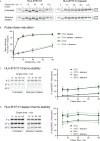Kinetics of Abacavir-Induced Remodelling of the Major Histocompatibility Complex Class I Peptide Repertoire
- PMID: 34093574
- PMCID: PMC8170132
- DOI: 10.3389/fimmu.2021.672737
Kinetics of Abacavir-Induced Remodelling of the Major Histocompatibility Complex Class I Peptide Repertoire
Abstract
Abacavir hypersensitivity syndrome can occur in individuals expressing the HLA-B*57:01 major histocompatibility complex class I allotype when utilising the drug abacavir as a part of their anti-retroviral regimen. The drug is known to bind within the HLA-B*57:01 antigen binding cleft, leading to the selection of novel self-peptide ligands, thus provoking life-threatening immune responses. However, the sub-cellular location of abacavir binding and the mechanics of altered peptide selection are not well understood. Here, we probed the impact of abacavir on the assembly of HLA-B*57:01 peptide complexes. We show that whilst abacavir had minimal impact on the maturation or average stability of HLA-B*57:01 molecules, abacavir was able to differentially enhance the formation, selectively decrease the dissociation, and alter tapasin loading dependency of certain HLA-B*57:01-peptide complexes. Our data reveals a spectrum of abacavir mediated effects on the immunopeptidome which reconciles the heterogeneous functional T cell data reported in the literature.
Keywords: MHC I antigen presentation; T cells; abacavir; drug hypersensitivity; immunopeptidome; peptide selection; tapasin.
Copyright © 2021 Illing, van Hateren, Darley, Croft, Mifsud, King, Kostenko, Bharadwaj, McCluskey, Elliott and Purcell.
Conflict of interest statement
The authors declare that the research was conducted in the absence of any commercial or financial relationships that could be construed as a potential conflict of interest.
Figures








Similar articles
-
Human leukocyte antigen class I-restricted activation of CD8+ T cells provides the immunogenetic basis of a systemic drug hypersensitivity.Immunity. 2008 Jun;28(6):822-32. doi: 10.1016/j.immuni.2008.04.020. Immunity. 2008. PMID: 18549801
-
[HLA-B*5701 and abacavir hypersensitivity reaction].Pathol Biol (Paris). 2010 Dec;58(6):e95-100. doi: 10.1016/j.patbio.2008.12.001. Epub 2009 Feb 24. Pathol Biol (Paris). 2010. PMID: 19243901 French.
-
Abacavir induces loading of novel self-peptides into HLA-B*57: 01: an autoimmune model for HLA-associated drug hypersensitivity.AIDS. 2012 Jul 17;26(11):F21-9. doi: 10.1097/QAD.0b013e328355fe8f. AIDS. 2012. PMID: 22617051 Free PMC article.
-
Studies on abacavir-induced hypersensitivity reaction: a successful example of translation of pharmacogenetics to personalized medicine.Sci China Life Sci. 2013 Feb;56(2):119-24. doi: 10.1007/s11427-013-4438-8. Epub 2013 Feb 8. Sci China Life Sci. 2013. PMID: 23393027 Review.
-
[Importance of HLA in Determining Individual Differences in the Onset of Adverse Drug Reactions].Yakugaku Zasshi. 2021;141(8):1001-1007. doi: 10.1248/yakushi.21-00120. Yakugaku Zasshi. 2021. PMID: 34334545 Review. Japanese.
Cited by
-
Immunopharmacogenomics: Mechanisms of HLA-Associated Drug Reactions.Clin Pharmacol Ther. 2021 Sep;110(3):607-615. doi: 10.1002/cpt.2343. Epub 2021 Jul 17. Clin Pharmacol Ther. 2021. PMID: 34143437 Free PMC article. Review.
-
Evidence of focusing the MHC class I immunopeptidome by tapasin.Front Immunol. 2025 May 8;16:1563789. doi: 10.3389/fimmu.2025.1563789. eCollection 2025. Front Immunol. 2025. PMID: 40406141 Free PMC article.
-
Practical Implementation of Genetics: New Concepts in Immunogenomics to Predict, Prevent, and Diagnose Drug Hypersensitivity.J Allergy Clin Immunol Pract. 2022 Jul;10(7):1689-1700. doi: 10.1016/j.jaip.2022.04.027. Epub 2022 May 6. J Allergy Clin Immunol Pract. 2022. PMID: 35526777 Free PMC article.
-
MHCpLogics: an interactive machine learning-based tool for unsupervised data visualization and cluster analysis of immunopeptidomes.Brief Bioinform. 2024 Jan 22;25(2):bbae087. doi: 10.1093/bib/bbae087. Brief Bioinform. 2024. PMID: 38487848 Free PMC article.
-
HLA-B*57:01-dependent intracellular stress in keratinocytes triggers dermal hypersensitivity reactions to abacavir.PNAS Nexus. 2024 Apr 2;3(4):pgae140. doi: 10.1093/pnasnexus/pgae140. eCollection 2024 Apr. PNAS Nexus. 2024. PMID: 38628599 Free PMC article.
References
-
- Yewdell JW, Anton LC, Bennink JR. Defective Ribosomal Products (DriPs): A Major Source of Antigenic Peptides for MHC Class I Molecules? J Immunol (1996) 157(5):1823–6. - PubMed
Publication types
MeSH terms
Substances
Grants and funding
LinkOut - more resources
Full Text Sources
Medical
Molecular Biology Databases
Research Materials

